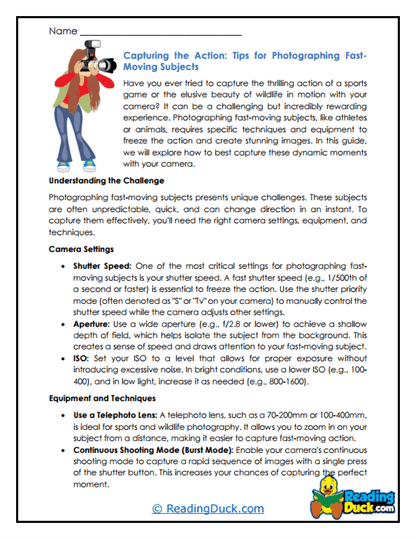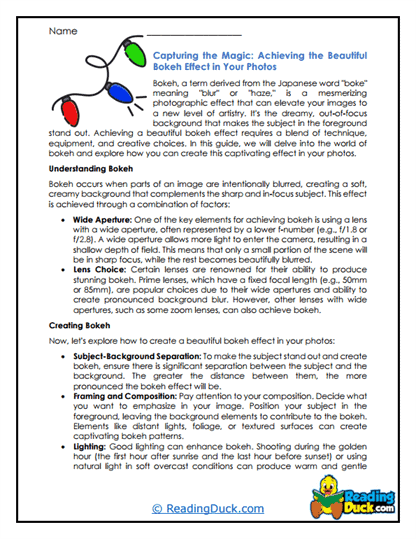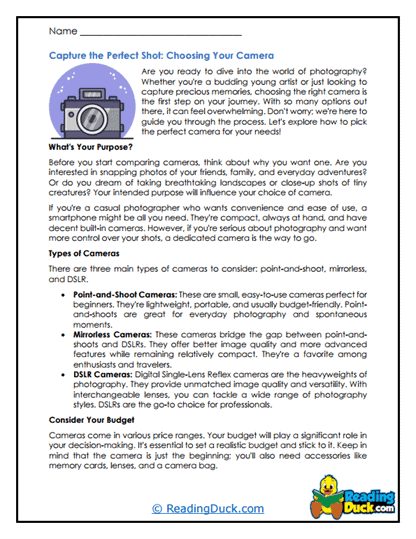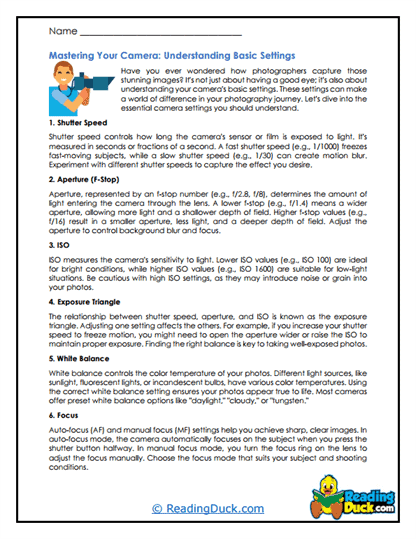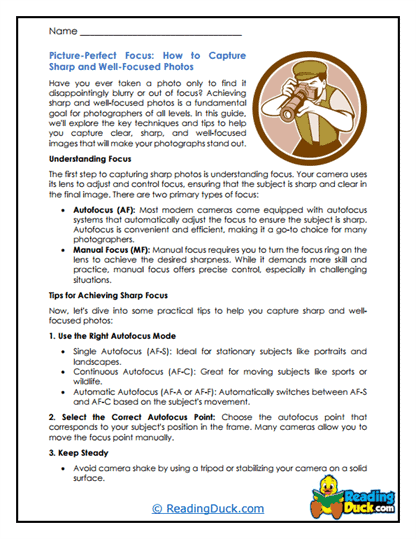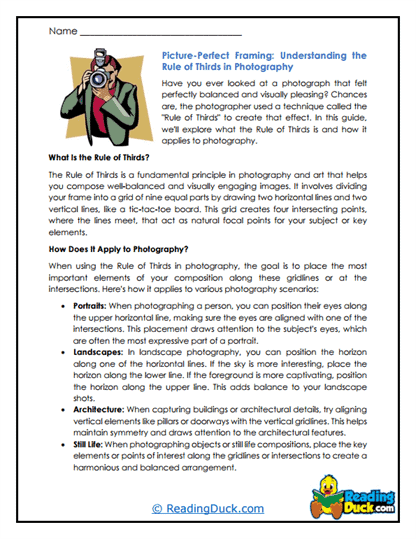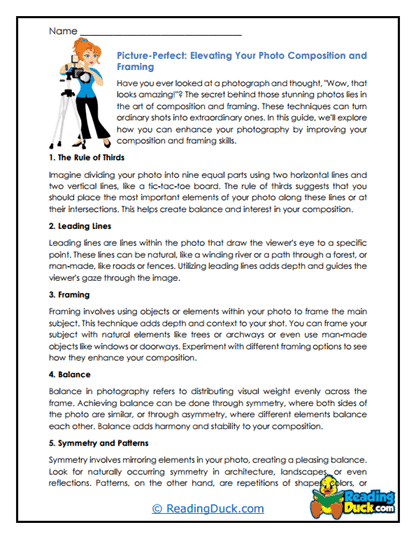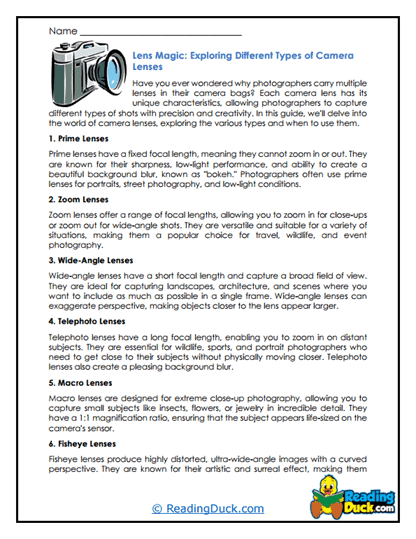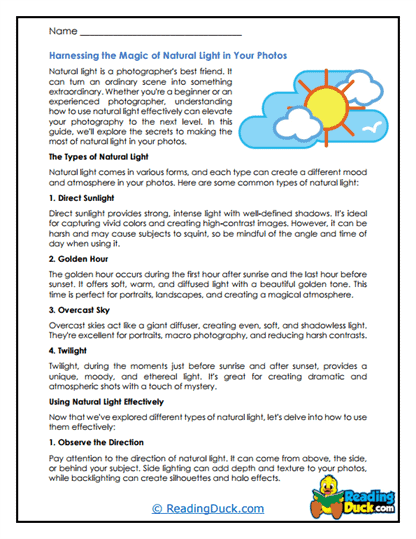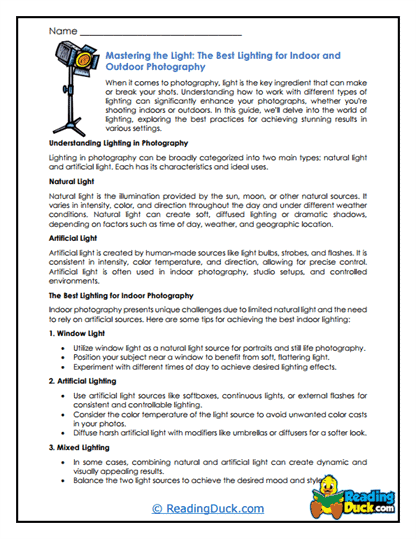Photography Worksheets
About Our Photography Worksheets
Our Photography Worksheets are designed to introduce students to the fascinating world of photography, a hobby that blends creativity, technical skills, and an eye for detail. These worksheets cover various aspects of photography, from understanding the basic principles of camera operation to exploring the art of composition and lighting. Whether students are new to photography or have some experience, these worksheets provide a structured way to deepen their knowledge and skills.
All worksheets in the Hobbies category cover a variety of popular hobbies, organized into categories such as Board Games, Collecting, Cooking, Gardening, Photography, Quilting and Sewing, Skateboarding, Toys, Video Games, and Yoga. These topics are chosen to reflect a broad spectrum of interests, ensuring there is something for every student to connect with.
The Photography Worksheets collection contains several worksheet sets, each focusing on one aspect of photography. Each worksheet set includes:
- Multiple Choice Questions: These questions assess students' understanding of the reading passages, which cover topics such as camera functions, types of photography, and the history of photography. The questions are designed to reinforce key concepts and ensure students grasp the essential elements of photography.
- Short Answer Questions: These prompts require students to explain specific photography techniques, describe the function of camera settings, or reflect on the impact of light and shadow in photography. For example, students might be asked to explain the rule of thirds, describe how to adjust exposure, or discuss the importance of framing in a photograph.
- Open-Ended Questions: These questions encourage students to express their thoughts and opinions on photography-related topics. Students might be asked to describe their favorite type of photography, discuss the influence of famous photographers, or explore how photography can be used to tell a story or evoke emotions.
These worksheets are designed to enhance students' comprehension and deepen their connection to the material. By engaging with the content through various types of questions, students can retain information better and develop a more personal interest in photography. Each worksheet includes an answer key to facilitate easy assessment. All worksheets are available as PDF files, making them accessible for electronic viewing, downloading, and printing.
Exploring the Art and Science of Photography
Photography is both an art form and a technical skill. It allows individuals to capture moments, tell stories, and express creativity through the lens of a camera. Students will explore a wide range of photography-related topics through these worksheets, gaining a comprehensive understanding of the field.
Here are some of the key aspects of photography that students will explore through these worksheets:
- Camera Basics: Understanding how a camera works is the foundation of photography. The worksheets cover essential topics such as:
- Camera Settings: Students will learn about various camera settings, including aperture, shutter speed, and ISO, and how they affect the final image. Understanding these settings is crucial for taking well-exposed and sharp photographs.
- Types of Cameras: The worksheets introduce different types of cameras, such as DSLRs, mirrorless cameras, and smartphone cameras, helping students understand the strengths and limitations of each.
- Lens Types and Functions: Students will explore the role of different lenses, such as wide-angle, telephoto, and macro lenses, and how they impact the perspective and composition of a photograph.
- Composition Techniques: Composition is the art of arranging elements within a photograph to create a balanced and visually appealing image. These worksheets will cover topics such as:
- The Rule of Thirds: Students will learn how to use the rule of thirds to create more dynamic and balanced compositions by placing the subject off-center.
- Leading Lines: The worksheets will explore how to use lines within a scene to guide the viewer's eye towards the subject, creating a sense of depth and movement.
- Framing and Perspective: Students will understand the importance of framing their subject within the scene and how to use perspective to add interest and dimension to their photographs.
- Lighting and Exposure: Lighting is one of the most critical elements in photography. These worksheets will help students understand how to control and manipulate light to enhance their images:
- Natural vs. Artificial Light: Students will explore the differences between natural and artificial light sources and how to use them effectively in different photography scenarios.
- Understanding Exposure: The worksheets will cover the concept of exposure, teaching students how to achieve the correct exposure by balancing aperture, shutter speed, and ISO.
- Using Shadows and Highlights: Students will learn how to use shadows and highlights to add contrast and drama to their photographs, making them more visually engaging.
- The History and Evolution of Photography: Understanding the history of photography helps students appreciate how the medium has evolved over time. These worksheets will cover topics such as:
- The Invention of the Camera: Students will explore the origins of photography, from the first camera obscura to the development of modern digital cameras.
- Pioneers of Photography: The worksheets will introduce students to famous photographers who have shaped the field, such as Ansel Adams, Dorothea Lange, and Henri Cartier-Bresson.
- The Impact of Photography on Society: Students will discuss how photography has influenced culture, journalism, and art, and how it continues to shape our understanding of the world.
- Creative Expression Through Photography: Photography is a powerful tool for self-expression and storytelling. These worksheets encourage students to explore their creativity:
- Telling a Story Through Images: Students will learn how to use a series of photographs to tell a story, convey a message, or evoke emotions.
- Experimenting with Styles and Genres: The worksheets will introduce students to various photography styles and genres, such as portrait, landscape, street, and abstract photography, encouraging them to experiment and find their unique voice.
- The Role of Post-Processing: Students will explore how post-processing techniques, such as cropping, color correction, and retouching, can enhance their photographs and bring their creative vision to life.
How to Effectively Use These Worksheets
To maximize the impact of these Photography Worksheets, teachers and parents can implement various strategies to engage students and foster a deeper interest in photography. Here are some tips on how to use these worksheets effectively:
- Encourage Hands-On Practice: Photography is a skill that is best learned through practice. Encourage students to take their cameras (or smartphones) and apply the concepts they learn in the worksheets by capturing their own images. They can experiment with different camera settings, compositions, and lighting techniques to see how these elements affect the final photograph.
- Incorporate Photography Projects: Teachers can integrate photography projects into the curriculum, allowing students to explore specific themes or styles. For example, a project might focus on portrait photography, where students capture images of their classmates or family members, or landscape photography, where they document local parks or nature scenes. The worksheets can guide students through these projects, helping them plan, execute, and reflect on their work.
- Create a Classroom Photo Gallery: Displaying students' photography in a classroom gallery can boost their confidence and pride in their work. Teachers can organize a photography exhibition where students showcase their best images, explain their creative process, and receive feedback from peers. The worksheets can serve as a foundation for these discussions, as students explain how they applied the techniques they learned.
- Incorporate Photography into Other Subjects: Photography can be a valuable tool in various subjects beyond art. For example, in science, students can document plant growth or animal behavior; in history, they can create visual reports on historical landmarks; and in language arts, they can pair images with written narratives or poetry. The worksheets can provide the technical knowledge needed to enhance these interdisciplinary projects.
- Encourage Reflection and Critique: Photography is a subjective art form, and developing an eye for critique is essential. Teachers and parents can encourage students to reflect on their work and the work of others by asking open-ended questions that prompt discussion and self-assessment. For example, students can analyze what worked well in their photographs, what challenges they faced, and how they might approach a similar project differently in the future.
- Explore Digital and Film Photography: While most students today are familiar with digital photography, exploring film photography can provide a new perspective on the medium. Teachers can introduce students to the basics of film photography, including how to load film, manually adjust settings, and develop photos. This hands-on experience can deepen students' appreciation for the art and history of photography.
- Use Photography as a Tool for Storytelling: Encourage students to use photography as a means of storytelling. They can create a photo essay on a topic of interest, such as documenting a day in their life, exploring a cultural event, or capturing the beauty of their surroundings. The worksheets can help guide them in planning their photo essay, selecting key images, and crafting a narrative that ties the photos together.
- Organize Photography Field Trips: If possible, organize field trips to locations that offer unique photographic opportunities, such as a botanical garden, a historical site, or an art museum. These outings provide students with a chance to practice their photography skills in real-world settings and apply the concepts they've learned. After the trip, students can use the worksheets to analyze their photos and reflect on their experiences.
By using these Photography Worksheets in conjunction with practical activities, teachers and parents can help students develop a deeper understanding of photography and cultivate a passion for this creative hobby. Photography is a versatile and accessible art form that can be enjoyed by students of all ages and skill levels, and these worksheets provide the foundation for a rewarding and lifelong interest in capturing the world through the lens.
Overall, the Photography Worksheets offer a comprehensive introduction to the art and science of photography. They are designed to inspire students to explore their creativity, develop technical skills, and appreciate the beauty and power of visual storytelling. Whether students are just beginning their photography journey or looking to refine their skills, these worksheets provide valuable insights and practical knowledge that will enhance their understanding and enjoyment of photography.
